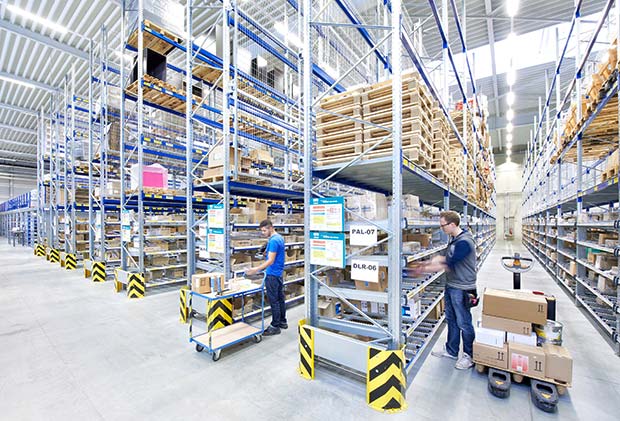Innovative design details often make the difference for successful storage and order picking, says Edward Hutchison, Managing Director of BITO Storage Systems.
 Developing logistics and supply chain techniques have generated a diverse array of intralogistics solutions tailored to meet the precise needs of individual operations. Order volumes, SKU numbers and sizes, order lead times, the temperature of the goods being stored and available space are just some of the variables that can pose specific challenges on a project. Often it will be the small, innovative design details that make the critical difference for designing a truly successful storage and order picking solution.
Developing logistics and supply chain techniques have generated a diverse array of intralogistics solutions tailored to meet the precise needs of individual operations. Order volumes, SKU numbers and sizes, order lead times, the temperature of the goods being stored and available space are just some of the variables that can pose specific challenges on a project. Often it will be the small, innovative design details that make the critical difference for designing a truly successful storage and order picking solution.
While new warehouses offer easy to use space, many operations have to make the best of the compromises inherent in older buildings, with their typically inconveniently located obstructions as well as irregular footprints and ceiling heights. Squeezing sufficient storage into these areas can be a real test of ingenuity. Even newer warehouses can come with obstructions – a cold store, for example, may have fans at the top of a wall where the company may want to put racking.
Faced with the challenge of fitting a required number of locations in a given volume that also successfully negotiates obstacles needs careful calculations to devise the right combination of beams and uprights. It may entail profiling the ceiling areas above top level bays to plot where full or half pallet positions will fit. Sometimes the maths refuses to add up as desired – and that’s when innovation is required.
The performance of racking and shelving in any storage and order picking application will very much depend upon the quality of the components and their manufacture. However, the performance of the solution will depend on the experience and the expertise of the supplier to produce a bespoke system that will overcome any compromises and ultimately lead to an improvement in productivity and operational costs.
Pallet racking may be at the core of a project, yet having the capability to engineer solutions for other key aspects such as shelving, picking carts and packing tables will allow a more holistic system. On one occasion, supplying bespoke racking led to BITO also designing special order picking carts equipped with detachable steps. The pallet racking was configured with a single pallet bay level, with shelving above to provide locations for unpalletised ‘returned to stock’ items. Operatives pick orders into the carts and the steps allow staff to reach the shelves above the pallet bay. The carts can be picked up and moved by an AGV (Automated Guided Vehicle) as if it were a pallet.
Ecommerce operations often require a large number of pick spaces to hold a broad range of SKUs. The perennial challenge is fitting all the locations in the limited amount of space that can be allocated to storage. One novel solution devised by BITO was a shelving system that would work in a similar way to a sliding wardrobe. Using boltless shelving formed the basis of the ‘Smart Slide’ system, which combines fixed shelving at the rear and a slideable shelving system at the front, giving pickers access to the full width of each bay at the rear.
Companies know their business best and often have their own great ideas for solutions to their particular issues – so sometimes it is a case of turning a client’s ideas into reality. Such was the case when a major online retailer wanted a shelving product of certain dimensions, which didn’t actually exist, and wanted dividers to be spaced to suit a robotic picking system. We manufactured a bespoke design to suit these specific requirements. The client was able to bring its own staff to test it and adjust it, to make sure it worked exactly as required and that its investment was maximised.
Try it out and get it right
With any bespoke design there will not, of course, be previous examples to refer to. It is important therefore to test out such a solution and fine-tune it to gain confidence in the end result. It is particularly beneficial to test carton and pallet live systems to see how they work, paying particular attention to ergonomics that allow the best system for staff to use throughout their shift. A client can bring their own items and containers to try out in a test facility or a sample system can be set up in a client’s own warehouse. This allows time to be spent finding the right height for the flow lanes and to select the right container to match its products. Having the opportunity to look at other products will further contribute to zeroing in on the most successful outcome. This may come through, for example, trying out a variety of containers to examine the pick efficiency and bay configurations required to get the optimum quantity needed on the given footprint. Testing will ultimately lead to a layout that saves an incredible amount of picking time.
A supplier that can contribute expertise and experience to the solution and offers a complete range of storage equipment, which can be seen in a showroom and tried out in a test facility, will help to contribute to a seamlessly integrated system. It also helps to have a single point of contact from the design and manufacture through to the installation and support. The passion and involvement at design stage should be continued through to project planning and then execution to deliver a truly successful storage and order picking project.




Comments are closed.